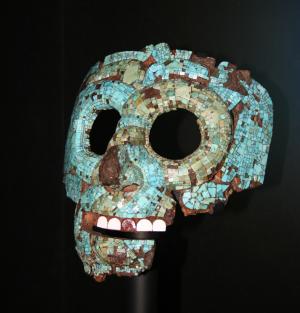The people of the ancient Mayan culture used a rare type of clay known as "palygorskite" to produce the color known as "Mayan Blue".

Dr. Moshe Nahamani
The people of the ancient Mayan culture used a rare type of clay known as "palygorskite" to produce the color known as "Maya blue". Thanks to the combination of structural, morphological and geochemical methods, Spanish researchers were able to accurately characterize the structure of this clay found in Mexico. The findings will make it possible to verify the origins of the materials used to create this color (pigment), which has survived both the ravages of time and the ravages of chemistry and the environment.
A Spanish research team traced the route used by the Mayan culture to obtain the palygorskite clay, one of the basic components of the color "Mayan blue" (Link to Wikipedia in English). "Our main goal was to determine if the Mayans produced this pottery from one particular site," explains one of the authors of the paper, physicist Manuel Sánchez del Río. The team examined several samples of this clay from a site in Mexico called the Yucatan Peninsula and compared them to samples from other sites. The findings appear in the latest edition of the journal Archaeometry.
The use of this clay in Central America was known since ancient times. Several sources of information imply that the Mayan people were aware of the properties of this material and that it was also important on their socio-cultural level.
"Today's indigenous communities, who live in the area, know the material and utilize it for a variety of uses, from making candles and decorating art objects to medicines for beetroot, stomach aches, pregnancy pains and diarrhea," explains the lead researcher. Today, contemporary pharmacy uses clays such as palygorskite to prepare anti-diarrhea medicines - a medicinal ingredient that the Mayan culture began to use over a thousand years ago.
However, the material was mainly used to prepare the dye "Mayan Blue", produced by mixing indigo, an organic dye produced from a plant of the same name, on the basis of this clay.
The researchers found samples that contained high-purity pottery at several sites in an area of about forty square kilometers of the well-known archaeological area of the Mayan culture in Uxmal. Some of these sites are well documented, but others were discovered for the first time by this research expedition. The fact that this type of clay was common in the samples collected verifies the hypothesis that the mineral was a common material in this area.
A crystal-chemical examination allowed the researchers to obtain the exact formula of the clay composition:
(Si7.96Al0.07)O20(Al1.59Fe3+0.20Mg2.25)(OH)2(OH2)4Ca0.02Na0.02K0.044(H20).
These findings will be useful for the study of archaeological remains painted Maya blue and for determining whether the origin of the clay that made up the color was in the area in question.
The color Maya Blue was developed between the sixth and eighth centuries and is found in sculptures, murals, ancient manuscripts and decorations throughout Central America, from the Gulf of Mexico to the Pacific Ocean. The color was discovered by scientists in 1931 who were amazed by the stability and durability of this color found on objects from before the time of Columbus.
This age-old dye, which has existed for about a thousand years, and which has proven its immunity to the ravages of time, rusting, biological degradation and contemporary solvents - is considered the pioneer material of the family of hybrid materials - compounds containing combined organic and inorganic components, with fascinating characteristics that can be used in high technology.
The original news - in Spanish
The news is in English
More on the subject on the science website

2 תגובות
Maya blue color, interesting.
I did not imagine that these things are also checked.
A little brings back associatively the mysteries of Smallville, Kal-El, etc. in one of the fascinating episodes in the past, for those who remember.